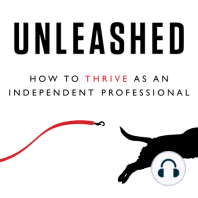23 min listen

568. Salah Zalatimo, Integrating AI into a 100-year-old Media Business
FromUnleashed - How to Thrive as an Independent Professional
568. Salah Zalatimo, Integrating AI into a 100-year-old Media Business
FromUnleashed - How to Thrive as an Independent Professional
ratings:
Length:
40 minutes
Released:
Apr 8, 2024
Format:
Podcast episode
Description
Salah Zalatimo, former Chief Digital Officer at Forbes, discusses the history of magazines and digital transformation. Magazines have been around for a while, with many well-known brands being founded around 100 years ago. Technological innovations have enabled new businesses to launch, such as the Direct to Consumer (DTC) boom and the cheaper printing costs around the turn of the last century. A Short History of the Magazine Industry Salah talks about the background of Forbes, which was launched around the Great Depression, and goes on to why the magazine industry was much like VC Investing today, and how it changed with the advent of the internet. The tension between maintaining journalistic integrity and separation was a challenge. However, the internet revolutionized the way magazines operated, leading to many magazines going out of business in the past 20 years. Integration with the Digital Media Space Salah started his career in 2001, drawn to the digital media space after experiencing the first broadband connection and discovering Napster and music. When he arrived at Forbes, he found it to be one of the few companies that successfully adapted to these new business models. Forbes had more traffic and audience than any other magazine and competed with some of the largest information and news websites in the world. He joined Forbes in 2016 and discovered that their adaptation to the new business model was kind of outside their capabilities. Forbes adopted a new business model in 2016 when they acquired True Slant, a platform that allowed writers to write articles and receive a revenue share on the content. This aligned the incentives of all stakeholders in the content creation process, with writers and publishers trying to generate more revenue and being paid based on the success of the content. Forbes adapted this business model to their own newsroom, increasing their content production and SEO significantly. How Forbes Maintained Zero Liability The Google algorithm, which was maturing at the time, was a link-sharing system, making it difficult to lose a lead in SEO. Forbes was one of the first companies to dramatically increase their content production and SEO, leaving everyone behind. This led to a virtuous cycle where writers had their own social media accounts and audiences, which added to putting Forbes ahead of the curve in terms of adaptation. However, content production still operated as a newsroom, and digital transformation was needed to adapt the business model. Salah explains why tension arose between traditional journalists and freelance journalists and how Forbes maintained zero liability for user-generated content.. Problems Facing The Digital Media Business Model The digital media business model is facing a number of problems, including misaligned incentives and the need for a more efficient business model. Digital advertising is the primary way to monetize the media today, and traditional newsrooms focus on journalistic excellence and fact-checking. Salah explains how Forbes addressed this issue which incentivized writers to optimize their content for new distribution channels like Google and Facebook. This led to a dramatic change in the way Forbes worked and enabled them to grow. Challenges Managing Freelance Writers The newsroom faced challenges in managing freelance writers and managing quotas, which created stress. As a technologist, it was clear to Salah that many of these tasks could be simplified, automated, and made more consistent and flexible. To improve processes and outcomes, the company looked at the publishing platform as an opportunity. WordPress, the most widely used platform, is meant for smaller publications, and it couldn’t handle the volume of Forbes. By aligning incentives and improving processes, Forbes was able to grow and thrive in a time when other digital media companies were either losing money or going sideways. How Forbes’ Platform Was Improved To improve the platform, Forb
Released:
Apr 8, 2024
Format:
Podcast episode
Titles in the series (100)
15. Will Bachman on 27 steps to set up your firm: In this in-between-isode, Will Bachman offers suggestions on 27 action items to consider as you set up your firm. by Unleashed - How to Thrive as an Independent Professional